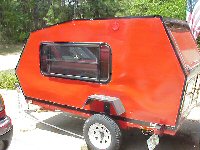I am making VERY slow progress getting my Little Guy ready for it's maiden voyage next week. I ordered a Hubbell 30 amp Inlet and extension cord and they just got here yesterday. Tonight, I nervously took on the task to boring out a 2 1/2" hole through the side wall. Boy, let me tell you...taking a hole saw after a brand new teardrop wall is a bit disconcerting. After putting the drill to the wall 3 times, I finally got brave and committed to drilling through the wall. Everything went fine and I made sure to use a new holesaw with a bit of lubricant to keep it from getting hot. Here is some pics of tonight's progress as I move forward trying to power up the teardrop.
Here's a pic of the outer wall right after I bored through it with the holesaw. I did halfway from the inside and the other half from the outside and I got very minimal splintering of the wood and fiberglass covering.
Here's a shot from the inside in the galley area showing the cutout for the Shore Power Inlet.
The inlet has been lined up and screwed into place temporarily.
The Hubbell Shore Power Inlet with the hatch open showing the 3 prong 30amp plug. The extension cord will screw onto this making a watertight seal.
Here's the back side of the inlet with the cord strain relief temporarily installed.
Not too bad for a first time modification on the Little Guy.
Now, since I shared pics, I need some advice everyone told me not to use Romex to wire the inlet to the converter since it's so stiff.
What gauge braided wire should I use to wire the inlet to the converter?
I also bought a WFCO 8735 3 Stage Converter which I have NO place to put it since room as at a premium in a Little Guy since we don't have the big galley....now I am trying to figure out where to mount the converter where it's out of the way and safe from water....Any thoughts???



